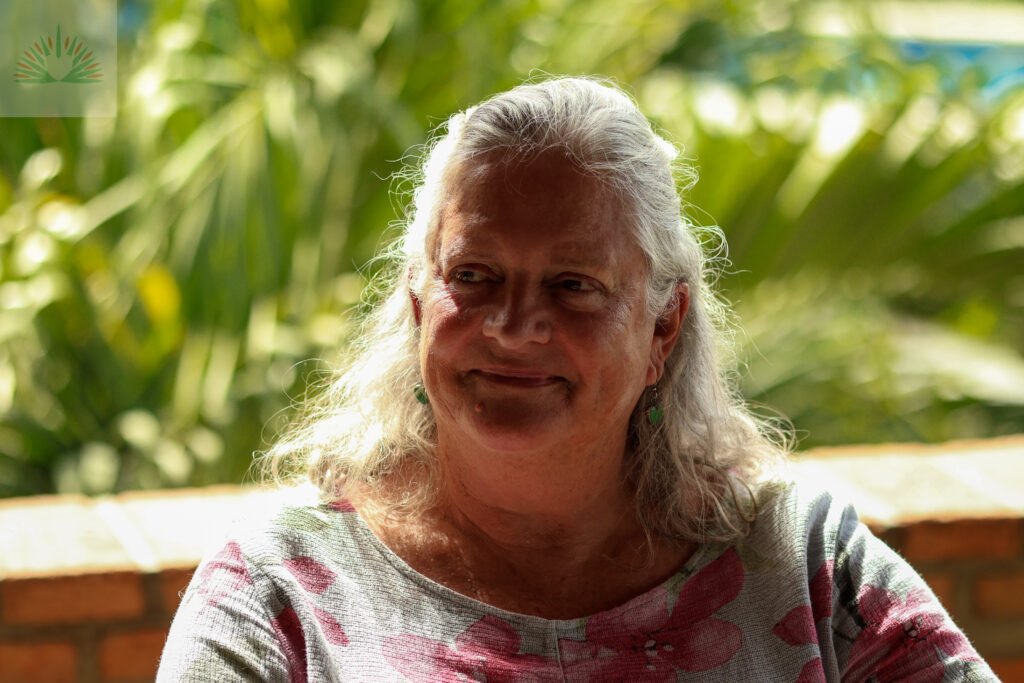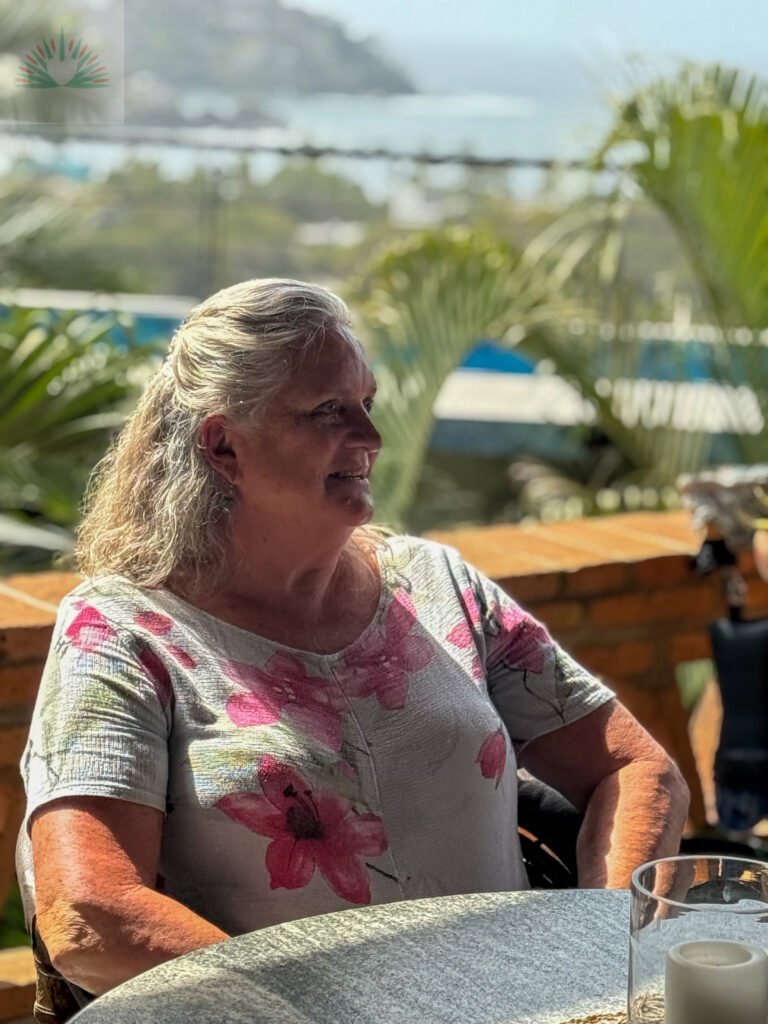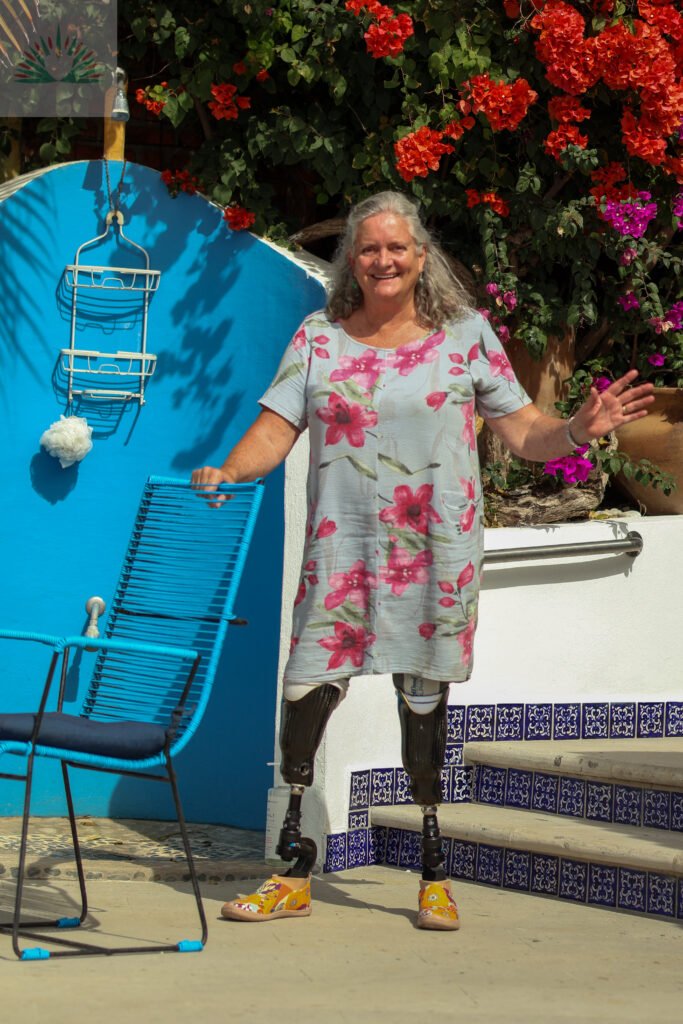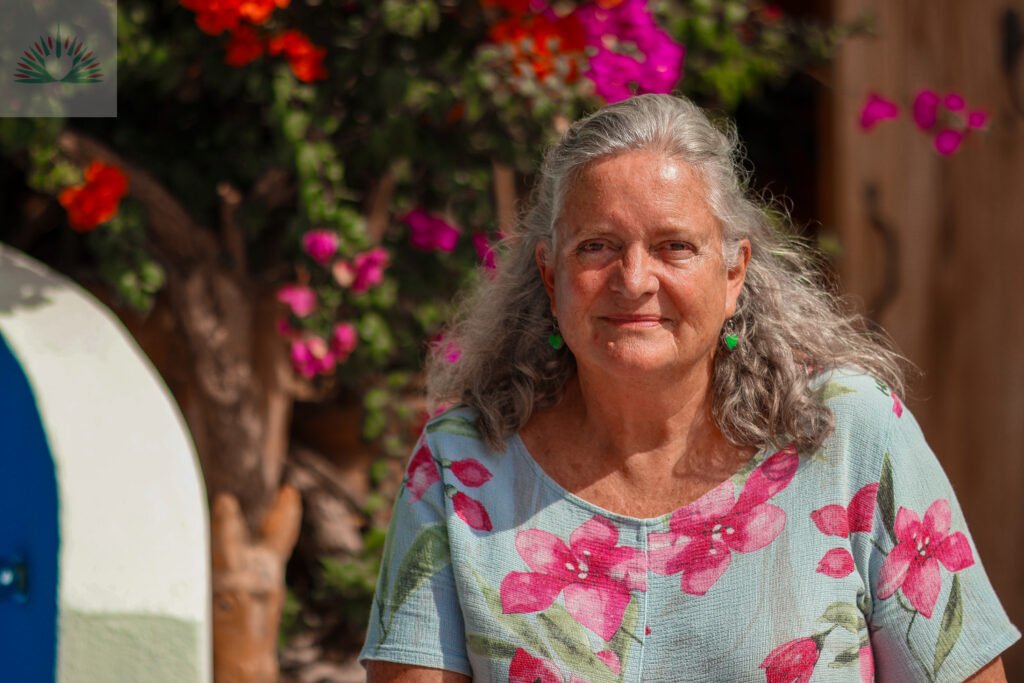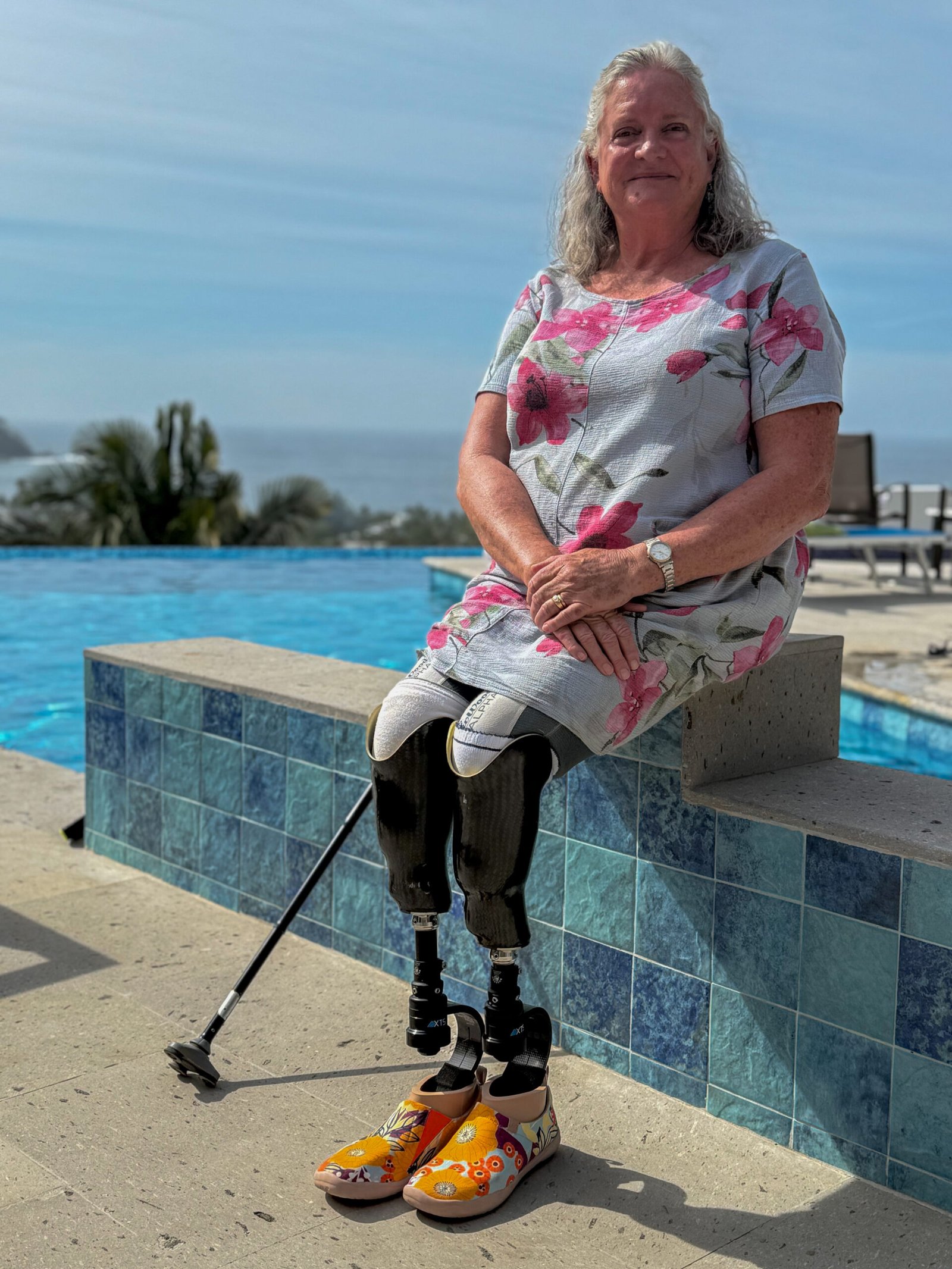A woman whose life was forever changed by a devastating explosion, and who found healing, purpose, and joy in the heart of Sayulita, Mexico. 🇲🇽🔥
What happens when life as you know it vanishes in an instant?
When the body that once carried you through mountains, beaches, and bike trails is suddenly… gone?
This is a story of fire. A story of hardship. A story of resilience. And, more than anything, a story of rebuilding a life in Sayulita, Mexico—one moment, one sunset, one sip at a time.
There are places in the world that give you more than just views—they offer perspective. And Sayulita, Mexico, through Karen’s eyes, is exactly that. Because sometimes, healing doesn’t come in a straight line. It comes in the form of laughter. Of salt air on a normal Tuesday, watching a baby whale breach the water as the sun sets over the Bay of Banderas.
“On Tuesday, I went on a sunset cruise on a big catamaran and saw a baby whale. Then, after we’d watched it for a while, it started breaching. It must have been just practicing because it was small. It was just… it was incredible…They come, uh, November through March. So they’re getting ready to leave now, and they go back up to Alaska. They come down, have their babies, and then they breed and they go back.”
As the whales make their yearly journey through the Bay of Banderas, so too has Karen traveled—across oceans, continents, and eventually, into a life she never expected. Sayulita might be home now, but her story begins far from here… in New Zealand.
“I was born in New Zealand. When I was 21, I left New Zealand and took off to see the world and spent years traveling, mainly in, um, Europe. Although I did go to South Africa…And then in 1980, I went to the United States for my first time… And it was all very simple. It was sort of almost… everything just went along like it was supposed to be.
“I think, really, the thing that changed my life was in 2015 when I lost my legs in a propane explosion. Because that changed everything.
“I turned on the grill and lit it ‘cause it needed cleaning. And that’s the best way to do it; heat it up first, and then clean it, and then use it. So I did that. The grill had a timer on the gas supply, so it… I mean, I assumed it ran out, and I was busy doing other things in the house, and we had a tequila, and we were going to have another tequila, and I said, “Oh, I’ve got to get this dinner going. It’ll be 9:00 o’clock before we eat.” It was a beautiful fall night, and we had the kitchen door wide open, and the leaves were all sort of rustling around.
“It was pretty late. It was October 20th, so it was late in the fall to be in the Rocky Mountains. And, I went out to relight the grill, and I clicked one of those big stick lighters, and there was this massive explosion. It came from underneath my feet and hit me, pushed me this way and up, and I hit my head on the top of the outdoor kitchen and, uh, lost a tooth, got burned but not badly.
“ Because propane doesn’t have a lot of fire—it’s more of an explosion. It’s a bomb, and then you don’t need… I found out since, you don’t need much propane to make a bomb.
“What had happened is that the timer had malfunctioned. So, after the grill went out, it still allowed gas, and the gas had pooled under my feet. So when I lit it, basically, my heels and the bottom part of my legs got blown off.
“George came running out. I was lying in a hole where the floor used to be. I said, ‘Call 9-1-1.’ And he just looked at me in horror. And I said, ‘Call 9-1-1…’
“They took me to Aspen, Aspen Valley Hospital, and stabilized me. And then they put me in a helicopter, which was my first helicopter ride…. And we had to land in Frisco because it was snowing, and so they took me out. And I was on this gurney and looking up at the snowflakes, you know, what it’s like if you look up at snow and it’s sort of like this crazy swirling thing.
“I asked the nurse, ‘Am I gonna die?’. And he said, ‘I don’t know.’
“It was a really weird feeling.
“And then they put me in an ambulance and took me the rest of the way. I must have conked out from the pain medication by then, and then when I woke up, I had one leg amputated below the knee, and the other had been operated on and it had pins and massive bandaging and pins and all sorts of things.
“So I was in the ICU, and they came in after five days, I think, and they said, ‘You could end up having surgery for 10 years. You are not gonna be able to walk on this leg because you don’t have a heel, and you gotta have a heel to walk.’
“So they recommended that I amputate that one as well. And evidently, I said yes. I can’t remember, but… And George and my son, our son Sam, was there too. We all decided, “Yeah, we should just go ahead and do this.” But it took a while to really sink in that this is what had happened to me.
It seemed like a really, really bad dream.”
In a split second, Karen’s life was cleaved into “before” and “after.” But while that explosion stole her legs, it sparked a deeper journey of survival, adaptation, and eventually, belonging
“I had, I think, seven surgeries in that hospital stay. I got out in December and went home, which was pretty difficult.
“I didn’t sleep. I was tired. My eyes would close, but I was never asleep. It was the weirdest thing.”
Even medications meant to help, like Versed, became their own horror.
“Well, I’m allergic to it and had hallucinations twice that lasted for about 24 hours, and scared the living daylights out of everybody, including me.
“It was terrifying.
“I was 60, and it felt as though for a while there that my life was over. But since then I have found out that I still can have a good life. I just have to do a few things differently, and there are some other things I don’t do at all. And, I just have to remind myself that I had 60 really, really good years and did a lot of amazing things and went to a lot of other countries and had a very good, full life.
“And now that I have this different life. And it’s still full and good. But just, I have prosthetics instead of legs below the knee.”
Recovery was grueling. There were complications, Her body rebelled with phantom pain and her mind wrestled with anesthesia-induced hallucinations. The woman who used to hike mountains now struggled to walk across her living room. Her body had changed, and so had her path. But giving up was never on the map.
“I’ve had nothing but support. People, people are so good to me, they really are, and they’re, they’re kind and they make special allowances for me. And I don’t think they ever did that before…
“To not be able to do anything is a huge step back. And you feel… it’s so frustrating! Even now, if I want to just do something in the house or, or, you know, just go sightseeing, I’m fine in the car, but I can’t walk very far because I’m still getting used to these prosthetics. I’ve had them almost a month, so I’m getting there, but once again, my legs are changing shape because they do.”
Karen didn’t just survive—she adapted. Her life in Colorado became more intentional.
“I was always a hiker. I miss that. That’s the thing—going for a walk, getting up in the morning, walking up the hill by our house, or walking here and around town, whatever. That’s really hard to give up. And it’s a… not being able to go camping, hiking, you know, that sort of thing. And I was always a bike rider, but three of my friends got together and ordered me an, easy rider, it’s called, and it’s an arm bike, and it’s an e-bike, and I get on that thing and ride like this (doing the peddling motions with her arms). You know, I can cook on that thing!”
Long before the explosion, Karen and her husband George had fallen in love with Mexico. In the 1980s, they drove an old minivan across the country. From Mazatlán to Belize. From Puerto Vallarta to Sayulita.
“We came to Sayulita, and we were sitting up at the upstairs part of Don Pedro’s, which had just opened in 93 or 4 and looking out at the guys surfing, I just thought it was the most gorgeous place I’ve ever seen.
“The beach… the beach had nothing on it. There were no umbrellas or chairs or anything. You could just walk on the beach, and there were hermit crabs scuttling along, and it’s a very, very nice place. The water was very clean.…
“I thought then, we were sitting there eating and having a nice Margarita or paloma, whatever it was we were drinking then, and I thought, “Oh, I just love to be able to live here. I’ll come here and spend my vacations.”
“And that was it, you know?
“After that, we did, and then in 2005, we bought this house, and we’ve been working on it ever since.”
They bought a hacienda-style home. Built a life. And when the explosion shattered everything, Karen knew one thing: She needed to get back. Sayulita had become more than a vacation—it became healing.
“There’s something about being here that is just… it’s not restful in a lot of ways because it’s so noisy, like the music that’s playing right now, but there’s something about it.
“And the people are really generous and kind and just lovely. They really, really are. And I love the fresh food every… I mean, there’s nothing bad to eat here. People will say to us, “What do you eat down there?” And you think, “What don’t we eat?” That’s the problem.
“I think it’s the sense of family, and you can be family whether you’re born to them or not, but once they know you, if they like you, nothing is too much for you. And they just, they take care of their parents, they take care of their children, they take care of everybody.
“And they can have fun so easily with so little. I’ve seen people down in Mangal, where our caretakers live, 30 people in a backyard sharing one bottle of champagne for somebody’s birthday, and everyone’s got a tiny little cup, and they’re just having fun, laughing, talking.”
It isn’t just celebrations and relaxation. Living here means navigating real challenges, especially with the exponential growth in tourism that Sayulita has experienced.
“Well, a lot of the time, the town will run out of water. We run out of water, we have to buy it by the PIPA truckload, which is about $100. I think last year, we ended up having to get maybe 10 of them over the course of the spring. A lot of these big buildings are built without thinking about the infrastructure. Where are you gonna get the water from? Where’s the electricity coming from? And where’s the sewer going? But, um, they have improved the sewage treatment and cleaned up the water. The water is actually very clean now, which is great.
“But there’s definitely good things about Sayulita being so popular now and bad things. It’s awfully crowded, it’s much noisier, but the infrastructure’s better, people have work. They used to have a time in the summer here where they called it the hungry months because they really didn’t have any money and, uh, now that doesn’t happen. The tourist trade is pretty much year-round.”
For many foreigners, tequila often carries the stain of party culture, it’s just another shot during the night. But for Karen, and to many in Mexico, tequila is something else entirely. It’s heritage.
“I love that it’s a natural thing, you know? Tequila is made traditionally anyway with no added chemicals. When you first go and you see those pineapples and they’re roasted, getting ready to roast them in these big ovens, the smell is like nothing you’ve ever smelled before. It has a hint of tequila in it, but it also has this, like, sweetness of… across between sugar and maple syrup and apple juice or whatever. It’s an amazing smell.
“If you go to one of the older distilleries, they’re amazing, and you see the stone where they crushed them and the poor little horse went around—all the men walked around with it.”
Her favorite? Herradura Reposado. Smooth, a little sweet—like Karen herself. She teaches us tequila isn’t just a drink. It’s ritual. It’s history. It’s everyday magic.
She recalls her first tequila tasting at Herradura—and how it left a mark.
“They’ve still got the employee housing they built and they have the big house where the patron lived. But also, it’s my favorite tequila just to drink on a daily basis.”
But she’s not here for frat party shots. Tequila, for Karen, is about connection—
“I think tequila is associated, outside of Mexico, with wild parties. Some people are shocked that I like to drink tequila on the rocks, but what’s the difference? They drink scotch on the rocks.
“There’s nothing better than having had a good day, and you sit down, watch the sunset, and have a lovely tequila in a glass. My friend calls them tumblers. Have a tumbler, and it’s just—it’s just, for me, it’s very, very relaxing. It doesn’t make me crazy. It doesn’t make me hungover. I mean, it could if I probably went nuts. But, I do, I really think that it’s one of those, one of those, um… things that probably has more to it than we know, you know? There is other stuff in the agave that no one’s really discovered yet.”
Karen’s voice isn’t just about healing from trauma—it’s about belonging. Not just in a town. But in a country. In a culture.
“Well, that I think it’s fairly obvious that I love Mexico, and I’ll argue with anybody that criticizes it unfairly. And, um, I also really, really count my blessings that I got—I have this life and get to come here and get away from winter. But it’s not just that. It’s coming here,
“There is more variety in culture, people, food, music than you could ever, ever imagine and don’t ever pigeonhole Mexicans in one certain way: with one certain look, or one style, or one kind of behavior. Look at Mexico as this incredible melting pot of so much history, and so much beauty, and so much—I mean, it’s been going on for a long time, much longer than we, you know, our culture, and the history behind how things got built, everything is mind-blowing. You just have to respect it and be prepared to, once again, have an open mind.”
It’s also about laughter and letting go of the things that once defined us.
“Um, you could ask me when I’m going to get my blades.”
“When are you going to get your blades?”
“I’m not… That’s what a lot of people ask me. What happened to you? When are you going to get your blades?…You guys, I didn’t run before. I just want to be able to walk.”
Karen’s story isn’t wrapped in pity. It’s wrapped in humor. Grit. Perspective.
“I think you, the most important thing you do is make a choice. You choose to be the best you can be and just keep at it day after day. And only one day, you’ll find that you’re singing or smiling or having a great time or… or somebody will forget that you have your problem, and your problem won’t seem quite as bad.
“There’s always someone worse off than you are, always.
“So I think people need to realize that they’re alive and they need to buck up and go on, be positive, be happy. Because you can get up in the morning and be a pain in the neck for everyone around you, and it gets you nowhere. I just… I don’t think you should ever, ever just let yourself wallow, because it doesn’t do any good. It really doesn’t.
“You’ve got to get up and get going.”
Her advice? Never wallow. Choose joy. Buck up. Be polite. And if you’re going to come to Mexico…
“Learn some Spanish, always be polite, use please and thank you. Don’t make assumptions about the people you meet. Wash your hands.
“Don’t expect that it’s going to be like it is at home. The reason you’re traveling is to see other places. If you want to go and stay in an all-inclusive resort and never leave the premises, why are you going? I think you need to get out there and, and travel around a bit or stay somewhere and leave, go out, go to different beaches, go to, or not just beaches, but different places, go and immerse yourself in whatever that place has got to offer.
“And there are so many beautiful cities to visit, you’ll never, I don’t know that really you could ever see them all properly. But for first-timers, I think Spanish is the most important, and be patient, especially in Mexico. Things don’t happen that quickly. But, that would basically be it. Just go with an open mind and enjoy yourself.”
What started as a life shattered by fire has become a celebration of resilience, love, and the vibrant spirit of Mexico. From prosthetics to palomas, Karen’s journey reminds us that strength isn’t about staying on the path you planned—it’s about finding a new way forward, whether you’re riding an arm bike through the streets of Colorado or sitting on a Sayulita porch with a tumbler of tequila in hand. Her life is a testament to finding new legs to stand on—even if they’re made of carbon fiber.
“Thank you so much.”
Thank you, Karen.
